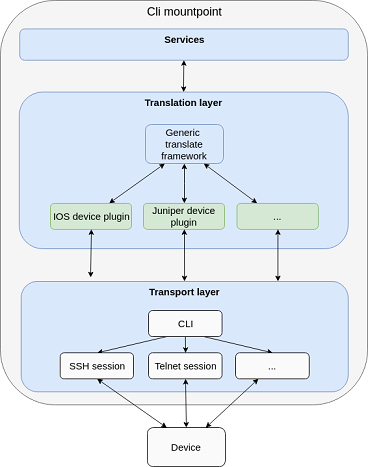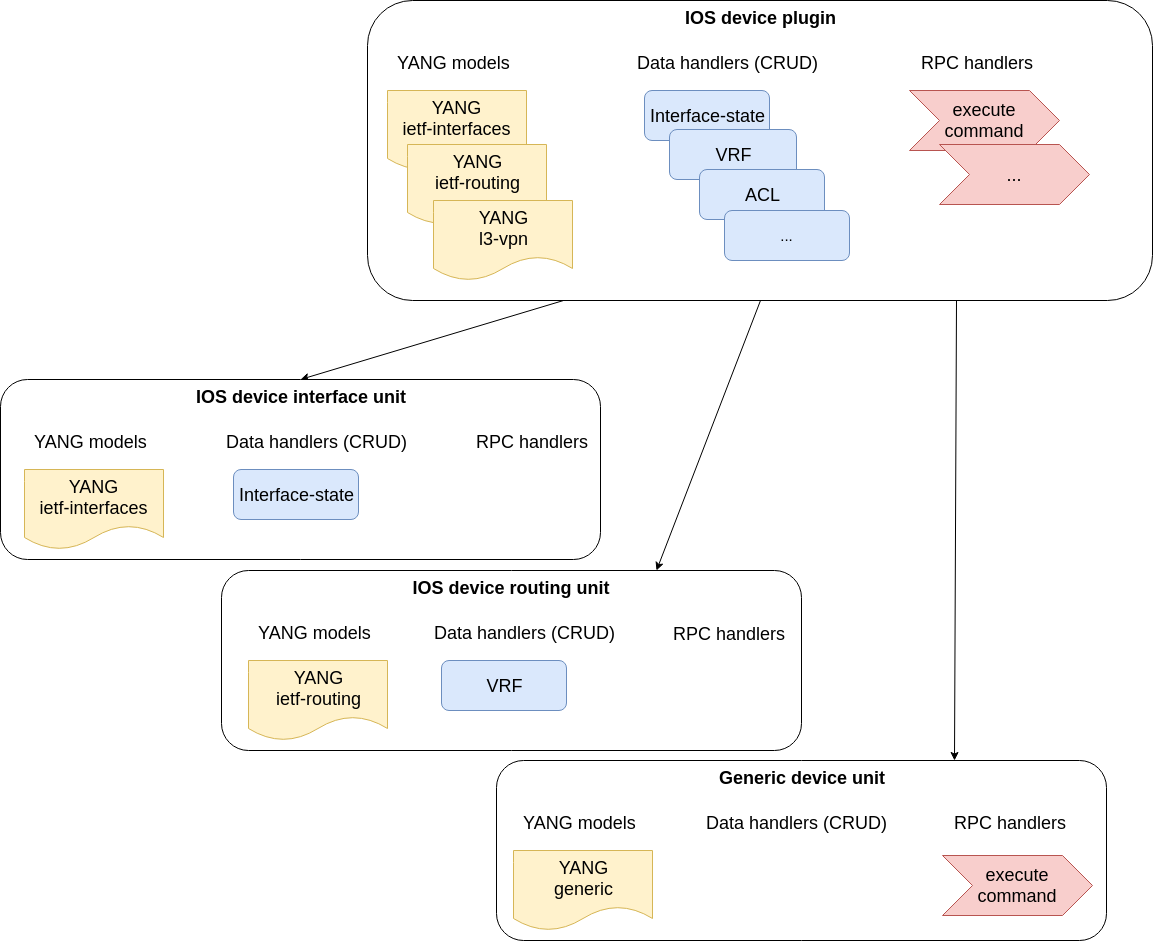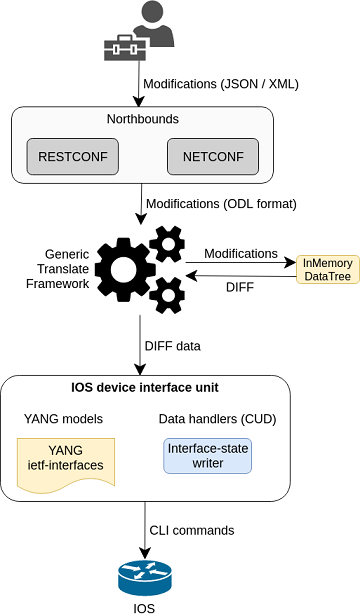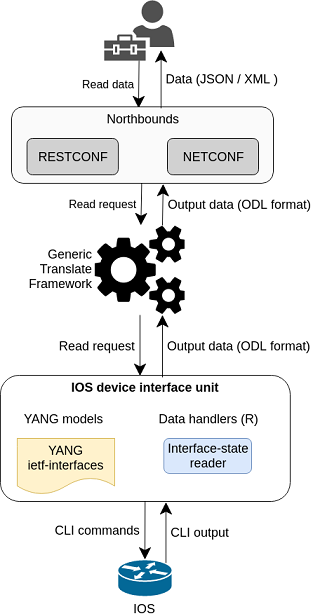#
UniConfig CLI
#
Introduction
The CLI southbound plugin enables the Frinx UniConfig to communicate with CLI devices that do not speak NETCONF or any other programmatic API. The CLI service module uses YANG models and implements a translation logic to send and receive structured data to and from CLI devices. This allows applications to use a service model or unified device model to communicate with a broad range of network platforms and SW revisions from different vendors.
Much like the NETCONF southbound plugin, the CLI southbound plugin enables fully model-driven, transactional device management for internal and external OpenDaylight applications. In fact, the applications are completely unaware of underlying transport and can manage devices over the CLI plugin in the same exact way as over NETCONF.
Once we have installed the device, we can present an abstract, model-based network device and service interface to applications and users. For example, we can parse the output of an IOS command and return structured data.

#
Architecture
This section provides an architectural overview of the plugin, focusing on the main components.
#
CLI topology
The CLI topology is a dedicated topology instance where users and applications can:
- install a CLI device,
- uninstall a device,
- check the state of connection,
- read/write data from/to a device,
- execute RPCs on a device.
This topology can be seen as an equivalent of topology-netconf, providing the same features for netconf devices. The topology APIs are YANG APIs based on the ietf-topology model. Similarly to netconf topology, CLI topology augments the model with some basic configuration data and also some state to monitor mountpoints.
#
CLI mountpoint
The plugin relies on MD-SAL and its concept of mountpoints to expose management of a CLI device. By exposing a mountpoint into MD-SAL, it enables the CLI topology to actually access the device's data in a structured/YANG manner. Components of such a mountpoint can be divided into 3 distinct layers:
- Service layer - implementation of MD-SAL APIs delegating execution to transport layer.
- Translation layer - a generic and extensible translation layer. The actual translation between YANG and CLI takes place in the extensions. The resulting CLI commands are then delegated to transport layer.
- Transport layer - implementation of various transport protocols used for actual communication with network devices.
The following diagram shows the layers of a CLI mountpoint:

#
Translation layer
The CLI southbound plugin is as generic as possible. However, the device-specific translation code (from YANG data -\ CLI commands and vice versa), needs to be encapsulated in a device-specific translation plugin. E.g. Cisco IOS specific translation code needs to be implemented by Cisco IOS translation plugin before FRINX UniConfig can manage IOS devices. These translation plugins in conjunction with the generic translation layer allow for a CLI mountpoint to be created.
#
Device specific translation plugin
Device specific translation plugin is a set of:
- YANG models
- Data handlers
- RPC implementations
that actually
- defines the model/structure of the data in FRINX UniConfig
- implements the translation between YANG data and device CLI in a set of handlers
- (optionally) implements the translation between YANG RPCs and device CLI
The plugin itself is responsible for defining the mapping between YANG and CLI. However, the translation layer into which it plugs in is what handles the heavy lifting for it e.g. transactions, rollback, config data storage etc. Additionally, the SPIs of the translation layer are very simple to implement because the translation plugin only needs to focus on the translations between YANG <-\ CLI.
#
Units
In order to enable better extensibility of the translation plugin and also to allow the separation of various aspects of a device's configuration, a plugin can be split into multiple units. Where a unit is actually just a subset of a plugin's models, handlers and RPCs.
A single unit will usually cover a particular aspect of device management e.g. the interface management unit.
Units can be completely independent or they can build on each other, but in the end (in the moment where a device is being installed) they form a single translation plugin.
Each unit has to be registered under a specific device type(s) e.g. an interface management unit could be registered for various versions of the IOS device type. When installing an IOS device, the CLI southbound plugin collects all the units registered for the IOS device type and merges them into a single plugin enabling full management.
The following diagram shows an IOS device translation plugin split into multiple units:

#
Transport layer
For now, two transport protocols are supported:
- SSH
- Telnet
They implement the same APIs, which enables the translation layer of the CLI plugin to be completely independent of the underlying protocol in use. Deciding which transport will be used to manage a particular device is simply a matter of install-request configuration.
The transport layer can be specified using install-request 'cli-topology:transport-type' parameter.
#
Data processing
There are 2 types of data depending on data-store in which data is stored:
- Config
- Operational
This section details how these data types map to CLI commands.
Just as there are 2 types of data, there are 2 streams of data in the CLI southbound plugin:
- Config
- It represents user/application intended configuration for the device.
- Translation plugins/units need to handle this configuration in data handlers as C(reate), U(pdate) and D(elete) operations. R(ead) pulls this config data from the device and updates the cache on its way back.

- Operational
- It represents actual configuration on the device, optionally statistics from the device.
- Translation plugins/units need to pull these data out of the device when R(ead) operation is requested.

- RPCs stand on their own and can encapsulate any command(s) on the device.
#
RPCs provided by CLI layer
There are multiple RPCs that can be used to send commands to a CLI session and optionally wait for command output. The CLI layer also provides one additional RPC for computing configuration coverage by cli-units. To use all of these RPCs, it is required to have an installed CLI device in the 'Connected' state.
#
RPC: Execute-and-read
#
Description
- Execution of the sequence of commands specified in the input. These commands must be separated by the new line - then, each of the command is executed separately.
- After all commands are executed, it is assumed, that the original command prompt (prompt that was set before execution of this RPC) appears on the remote terminal.
- If the input contains only single command, output of this RPC will contain only output of this command. If input contains multiple commands separated by newline, output of this RPC will be built from command prompts (except the prompt of the first command), input commands and outputs returned from remote terminal.
#
Example
Following RPC demonstrates listing of all interfaces with configured IP addresses plus listing of available routing protocols that can be enabled from global configuration mode. Since the last entered command is placed in configuration mode (for example, starting with 'Router(config)#'), it is required to return back to Privileged EXEC mode (for example, starting with 'Router#') using 'end' command and 'no' confirmation to not save changes. Also, 'wait-for-output-timer' is configured to 2 seconds - CLI layer waits for command output returned from device up to 2 seconds.
Remember that the last command prompt must equal to original prompt otherwise CLI session fails on timeout and CLI mountpoint must be recreated.
curl --request POST 'http://127.0.0.1:8181/rests/operations/network-topology:network-topology/topology=cli/node=xrcli/yang-ext:mount/cli-unit-generic:execute-and-read' \
--header 'Content-Type: application/json' \
--data-raw '{
"input": {
"command": "show ip int brief
conf t
router ? rip
end
no",
"wait-for-output-timer": 2
}
}'RPC reply with unescaped output string (output can be easily unescaped with 'printf' linux application):
{
"output": {
"output": "show ip int brief
Fri Jan 24 12:45:00.498 UTC
Interface IP-Address Status Protocol Vrf-Name
MgmtEth0/0/CPU0/0 192.168.1.214 Up Up default
GigabitEthernet0/0/0/0 unassigned Shutdown Down default
GigabitEthernet0/0/0/1 unassigned Up Up default
GigabitEthernet0/0/0/2 unassigned Up Up default
GigabitEthernet0/0/0/3 unassigned Up Up default
GigabitEthernet0/0/0/4 unassigned Up Up default
RP/0/0/CPU0:XR5#conf t
Fri Jan 24 12:45:02.828 UTC
RP/0/0/CPU0:XR5(config)#router ?
amt Automatic Multicast Tunneling (AMT)
bgp BGP configuration subcommands
eigrp EIGRP configuration subcommands
hsrp HSRP configuration subcommands
igmp IPv4 Address Family
isis ISO IS-IS
lisp LISP configuration subcommands
mld IPv6 address family
msdp MSDP configuration subcommands
ospf OSPF configuration subcommands
ospfv3 IPv6 Open Shortest Path First protocol (OSPFv3)
pim PIM configuration subcommands
rib RIB configuration subcommands
rip RIP configuration subcommands
rpl IPv6 Routing Protocol for Low-Power and Lossy Networks (RPL)
static Static route configuration subcommands
vrrp VRRP configuration subcommands
RP/0/0/CPU0:XR5(config)#router rip
RP/0/0/CPU0:XR5(config-rip)#end
Uncommitted changes found, commit them before exiting(yes/no/cancel)? [cancel]:"
}
}Description of RPC-request input body fields:
- command (mandatory) - The list of commands that are sent to device. Commands must be separated by newline character. Every command-line is executed separately.
- wait-for-output-timer (optional) - By default (if this parameter is not set or set to 0), outputs from entered commands are collected after caught echo of the next typed command in CLI session (or command prompt, if the command is the last one from input sequence). Then, the collected output contains output of the previous command + echo of the current command that hasn't been executed by sending newline character yet. This process is simplified by setting 'wait-for-output-timer' value. In this case, 'waiting-for-command-echo' procedure is not applied, rather next command is executed only after specified number of seconds after which the reply from CLI session should already be available (if it won't be available, then command output will be read after execution of the next command - outputs can be messed up).
- error-check (optional) - By default, UC does not check for errors in commands. If error-handling is enabled and an error occurs, RPC will fail.
#
Wait-for-echo behaviour
The comparison between described wait-for-echo approaches can be demonstrated in the steps of processing 2 command-lines:
'wait-for-output-timer' is not set or it set to value 0
- write command 1
- wait for command 1 echo
- hit enter
- write command 2
- wait for command 2 echo
- hit enter
- read until command prompt appears
'wait-for-output-timer' is specified in request
- write command 1
- hit enter
- read output until timeout expires
- write command 2
- hit enter
- read until command prompt appears
Even if the 'wait-for-output-timer' is configured, the last output must equal to original command-prompt.
#
RPC: Execute-and-expect
#
Description
- It is a form of the 'execute-and-read' RPC that additionally may contain 'expect(..)' patterns used for waiting for specific outputs/prompts. It can be used for execution of interactive commands that require multiple subsequent inputs with different preceding prompts.
- The body of 'expect(..)' pattern must be specified by Java-based
regular expression typed between the brackets (see
https://docs.oracle.com/javase/7/docs/api/java/util/regex/Pattern.html
- documentation about regular expressions used in Java language).
- 'expect(..)' pattern can only be used for testing of previous command line output including next command prompt. From this reason, it is also a suitable tool for testing of specific command prompts.
- 'expect(..)' pattern must be specified on the distinct line. If multiple 'expect(..)' patterns are chained on neighboring lines, then all of them must match previous output (patterns are joined using logical AND operation).
- Output of this RPC reflects the whole dialogue between Frinx UniConfig client and remote terminal except the initial command-prompt.
- 'wait-for-output-timer' parameter can also be specified in this RPC
- but in this case, it applies only for non-interactive commands - commands that are not followed by 'expect(..)' pattern. It is possible to mix interactive and non-interactive commands in input command snippet.
- If 'expect' pattern doesn't match previous output, Execute-and-expect RPC will fail on timeout (fixed 3 seconds) for reading next input and CLI session will drop immediately.
#
Example
The following RPC requests shows execution of interactive command for copying of file from TFTP server. The CLI prompt subsequently ask for source filename and destination filename. These prompts are asserted by 'expect(..) pattern. The last 'expect(..) pattern just waits for confirmation about number of copied bytes.
curl --request POST 'http://127.0.0.1:8181/rests/operations/network-topology:network-topology/topology=cli/node=iosxr/yang-ext:mount/cli-unit-generic:execute-and-expect' \
--header 'Content-Type: application/json' \
--data-raw '{
"input": {
"command": "copy tftp://192.168.1.40 disk0:/
expect(.*Source filename.+\\?.*)
sample_file.txt
expect(.*Destination filename.+\\?.*)
config2.conf
expect(.*\\d+\\s+bytes copied in\\s+\\d+\\s+sec.*)
"
}
}'RPC reply with unescaped output string (output can be easily unescaped with 'printf' linux application):
{
"output": {
"output": "copy tftp://192.168.1.40 disk0:/
Sun Jan 26 17:36:21.371 UTC
Source filename [/tftp:]?sample_file.txt
Destination filename [/disk0://sample_file.txt]?config2.conf
Accessing tftp://192.168.1.40/sample_file.txt
C
17 bytes copied in 0 sec
RP/0/0/CPU0:PE1#"
}
}Backslash is a special character that must be escaped in JSON body. From this reason, in the previous example, there are two backslashes proceeding regular-expression constructs.
If 'execute-and-expect' command field doesn't contain any 'expect(..)' patterns, it will be evaluated in the same way like 'execute-and-read' RPC.
#
RPC: Execute-and-read-until
#
Description
- It is form of the 'execute-and-read' RPC that allows to explicitly specify 'last-output' that CLI expect at the end of commands executions (after the last command has been sent to device).
- If explicitly specified 'last' output is not found at the end of the output, again, the session will be dropped and recreated similarly to behaviour of 'execute-and-read' RPC.
#
Example
The following request shows sending of the configuration snippet for disabling of automatic network summary (RIP routing protocol). After executing of these commands, command prompt is switched to 'RP/0/0/CPU0:XR5(config-rip)#' - it is not the same like initial command prompt 'RP/0/0/CPU0:XR5#'. From this reason it is required to return back to initial command prompt by sending of additional commands or specification of 'last-output' as it is demonstrated in this example.
curl --request POST 'http://127.0.0.1:8181/rests/operations/network-topology:network-topology/topology=cli/node=iosxr/yang-ext:mount/cli-unit-generic:execute-and-read-until' \
--header 'Content-Type: application/json' \
--data-raw '{
"input": {
"command": "conf t
router rip
no auto-summary",
"wait-for-output-timer": 2,
"last-output": "RP/0/0/CPU0:XR5(config-rip)#"
}
}'RPC reply with unescaped output string (output can be easily unescaped with 'printf' linux application):
{
"output": {
"output": "conf t
Mon Jan 27 08:11:35.005 UTC
Current Configuration Session Line User Date Lock
00000000-04c990b0-00000000 vty1 cisco Mon Jan 27 08:07:46 2020
RP/0/0/CPU0:XR5(config)#router rip
RP/0/0/CPU0:XR5(config-rip)#"
}
}Set 'last-output' is saved within current CLI session - if you send next 'execute-and-read' RPC, it is assumed that the initial and last output is newly configured 'last-output'.
#
RPC: Execute
#
Description
- Simple execution of single or multiple commands on remote terminal. Multiple commands must be separated by newline in the input. The outputs from commands are not collected - output of this RPC contains only status message.
- This RPC can be used in cases where it is not necessary to obtain outputs of entered commands.
- After all commands are executed, the last output is not checked against expected output.
#
Example
The following example demonstrates 'execute' RPC on creation of simple static route and committing of made change.
curl --request POST 'http://127.0.0.1:8181/rests/operations/network-topology:network-topology/topology=cli/node=xrcli/yang-ext:mount/cli-unit-generic:execute' \
--header 'Content-Type: application/json' \
--data-raw '{
"input": {
"command": "conf t
router static address-family ipv4 unicast 50.50.50.0/24 GigabitEthernet 0/0/0/3
end
yes
",
"wait-for-output-timer": 2
}
}'RPC reply - output contains just status message:
{
"output": {
"status": "ok"
}
}
#
RPC: config-coverage
#
Description
RPC reads the entire device configuration, determines the coverage of the configuration by translation units and returns simple or complex output. The user can define a preferred output in RPC input. The default is simple output.
Simple output contains one string that consists of all lines of the device configuration. Each line starts with '+' if it is covered or '-' if not and ends with a '\n' marker.
Complex output contains a list of commands. Each entry in the list includes the following fields:
'covered', which indicates whether the entire command is covered or not. Can be either 'true' or 'false'.
'non-parsable-parts', which is visible only if the entire command is not covered. Contains a list of those command parts that are not covered. If no parts of the command are covered, only contains the word 'ALL'.
'command', which includes the entire command.
#
Simple output example
curl --request POST 'http://127.0.0.1:8181/rests/operations/network-topology:network-topology/topology=cli/node=saos/yang-ext:mount/cli-unit-generic:config-coverage' \
--header 'Content-Type: application/json' \
--data-raw '{
"input": {
"with-details": false
}
}'RPC reply:
{
"output": {
"simple-output": "+ access-list create acl-profile act-test default-filter-action deny\n
+ vlan create vlan 104,147\n
+ vlan create vlan 190-193,200\n
- log flash add filter default ldp-mgr info\n
+ port set port 5 acceptable-frame-type all\n
+ port set port 16 max-frame-size 9216 description FREE resolved-cos-remark-l2 true\n
- traffic-services queuing congestion-avoidance-profile create profile Q1-BE green-lower-threshold 10\n
+ traffic-services queuing egress-port-queue-group set queue 0 port 8 eir 1000000 ebs 768 scheduler-weight 40 congestion-avoidance-profile Q0-BE\n"
}
}
#
Complex output example
curl --request POST 'http://127.0.0.1:8181/rests/operations/network-topology:network-topology/topology=cli/node=saos/yang-ext:mount/cli-unit-generic:config-coverage' \
--header 'Content-Type: application/json' \
--data-raw '{
"input": {
"with-details": true
}
}'RPC reply:
{
"output": {
"complex-output": [
{
"covered": true,
"command": "access-list create acl-profile act-test default-filter-action deny"
},
{
"covered": true,
"command": "vlan create vlan 104,147"
},
{
"covered": true,
"command": "vlan create vlan 190-193,200"
},
{
"covered": false,
"non-covered-parts": [
"ALL"
],
"command": "log flash add filter default ldp-mgr info"
},
{
"covered": true,
"command": "port set port 5 acceptable-frame-type all"
},
{
"covered": true,
"command": "port set port 16 max-frame-size 9216 description FREE resolved-cos-remark-l2 true"
},
{
"covered": false,
"non-covered-parts": [
"congestion-avoidance-profile",
"create",
"profile",
"Q1-BE",
"green-lower-threshold",
"10"
],
"command": "traffic-services queuing congestion-avoidance-profile create profile Q1-BE green-lower-threshold 10"
},
{
"covered": true,
"command": "traffic-services queuing egress-port-queue-group set queue 0 port 8 eir 1000000 ebs 768 scheduler-weight 40 congestion-avoidance-profile Q0-BE"
}
]
}
}